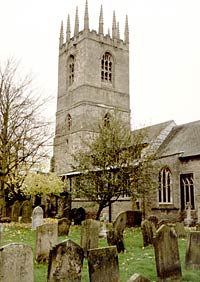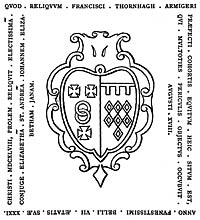< Previous | Contents | Next >
The Tower on the Roman Road

Sturton-le-Steeple church in 2001.
STURTON-LE-STEEPLE. Gladdened by gay gardens and grass-bordered roads, it carries some of its story in its name, for this town-on-the-street lies in the line of the Roman road from Lincoln to Doncaster, and is dominated by a splendid tower. With a lovely crown of battlements and 12 pinnacles, 9 windows, and a lofty arch, the tower is 600 years old in its lower half, and the upper storeys are 15th century. It is almost the only part of the church which escaped a fire at the beginning of this century; the rest has been reconstructed on the old lines with much of the old material.
The chancel is said to have been the original Norman church, and with the Norman masonry in its north wall is a Norman window now open to the vestry. The north and south doorways are Norman, and so is the bowl of the font, which came from the vanished church of West Burton; it is charmingly set on a flight of steps in the tower. An old piscina is restored, and the chancel screen is part of the beautiful modern woodwork here.
The oldest of the monuments is the stone figure of a woman in a wimple and a long gown, her hands at prayer. Though she has lain here 700 years her features are still clear. She was Lady Olive, and is believed to be one of the Thornhaughs who built the nave at the end of Norman days. They lived at Fenton half a mile away, but only the laundry and a few stone ornaments are left of their old home.
For a time Fenton belonged to a family who bore its name, and it is believed that Edward Fenton, the Elizabethan seaman, was born here. One of the bravest and most skilful of naval heroes, he accompanied Martin Frobisher in the voyage of discovery of the North-West passage, and was pilot in the Admiral's ship in the fight that led to the defeat of the Armada.

Sir Francis Thornhaugh's floorstone.
Standing erect under a pillared canopy against the tower wall is the figure of Dame Frances Earle, blackened by fire, with a wrap over her head and draped round her. She was the mother of one of the Thornhaughs, and died about 1699 when 80 years old. Their most interesting memorial is a floorstone with arms inlaid in coloured marbles, marking the resting-place of Sir Francis Thornhaugh, the great Parliamentarian and friend of Colonel Hutchinson, whose wife wrote an account of his brave death at the Battle of Preston.
